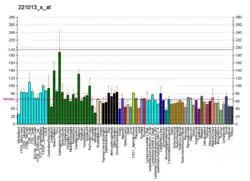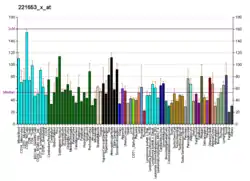APOL2
Apolipoprotein L2 is a protein that in humans is encoded by the APOL2 gene.[5][6][7]
This gene is a member of the apolipoprotein L gene family and protein in this family are lipid-binding proteins. This gene encodes a 37.1 kDa protein and The protein sequence contains 337bp. Localization of this protein is mainly found in the cytosol, nucleoplasm and additionally, it is also seen in the Nuclear bodies.[8] The involvement of this gene may affect in the movement of lipids and binding of lipids to organelles. Two transcript variants encoding the same protein have been found for this gene.[7]
Protein Sequence
>sp|Q9BQE5|1-337
MNPESSIFIEDYLKYFQDQVSRENLLQLLTDDEAWNGFVAAAELPRDEADELRKALNKLA
SHMVMKDKNRHDKDQQHRQWFLKEFPRLKRELEDHIRKLRALAEEVEQVHRGTTIANVVS
NSVGTTSGILTLLGLGLAPFTEGISFVLLDTGMGLGAAAAVAGITCSVVELVNKLRARAQ
ARNLDQSGTNVAKVMKEFVGGNTPNVLTLVDNWYQVTQGIGRNIRAIRRARANPQLGAYA
PPPHIIGRISAEGGEQVERVVEGPAQAMSRGTMIVGAATGGILLLLDVVSLAYESKHLLE
GAKSESAEELKKRAQELEGKLNFLTKIHEMLQPGQDQ
Splice Variants
ApoL2 has 5 splice variants,[13]
- APOL2-001
This transcript has got 6 exons, 12 domains and features are annotated, 263 variations are related this and maps to 35 oligo probes.
- APOL2-002
This transcript has got 5 exons, 12 domains and features are annotated, 263 variations are related with this gene and maps to 37 oligo probes.
- APOL2-006
This transcript has got 6 exons, is annotated with 3 domains and features, 62 variations are related with this gene and maps to 20 oligo probes.
- APOL2-008
This transcript has got 6 exons, 12 domains and features are annotated, 331 variations are related with this gene and maps to 32 oligo probes.
- APOL2-009
This transcript has got 5 exons, 4 domains and features are annotated, 104 variations are related with this gene and maps to 13 oligo probes.
Functions of the ApoL2
References
- GRCh38: Ensembl release 89: ENSG00000128335 - Ensembl, May 2017
- GRCm38: Ensembl release 89: ENSMUSG00000056656 - Ensembl, May 2017
- "Human PubMed Reference:". National Center for Biotechnology Information, U.S. National Library of Medicine.
- "Mouse PubMed Reference:". National Center for Biotechnology Information, U.S. National Library of Medicine.
- Dunham I, Shimizu N, Roe BA, Chissoe S, Hunt AR, Collins JE, Bruskiewich R, Beare DM, Clamp M, Smink LJ, Ainscough R, Almeida JP, Babbage A, Bagguley C, Bailey J, Barlow K, Bates KN, Beasley O, Bird CP, Blakey S, Bridgeman AM, Buck D, Burgess J, Burrill WD, O'Brien KP, et al. (Dec 1999). "The DNA sequence of human chromosome 22". Nature. 402 (6761): 489–95. doi:10.1038/990031. PMID 10591208.
- Page NM, Butlin DJ, Lomthaisong K, Lowry PJ (May 2001). "The human apolipoprotein L gene cluster: identification, classification, and sites of distribution". Genomics. 74 (1): 71–8. doi:10.1006/geno.2001.6534. PMID 11374903.
- "Entrez Gene: APOL2 apolipoprotein L, 2".
- "The Human Protein atlas Gene: APOL2 apolipoprotein L, 2".
- Liao W, Goh FY, Betts RJ, Kemeny DM, Tam J, Bay BH, Wong WS (February 2011). "A novel anti-apoptotic role for apolipoprotein L2 in IFN-gamma-induced cytotoxicity in human bronchial epithelial cells". J Cell Physiol. 226 (2): 397–406. doi:10.1002/jcp.22345. PMID 20665705.
- Bruening J, Lasswitz L, Banse P, Kahl S, Marinach C, Vondran FW, Kaderali L, Silvie O, Pietschmann T, Meissner F, Gerold G (July 2018). "Hepatitis C virus enters liver cells using the CD81 receptor complex proteins calpain-5 and CBLB". PLOS Pathogens. 14 (7): 55–67. doi:10.1371/journal.ppat.1007111. PMC 6053247. PMID 30024968.
- Smith EE, Malik HS (May 2009). "The apolipoprotein L family of programmed cell death and immunity genes rapidly evolved in primates at discrete sites of host-pathogen interactions". Genome Res. 19 (5): 850–8. doi:10.1101/gr.085647.108. PMC 2675973. PMID 19299565.
- Liu Z, Lu H, Jiang Z, Pastuszyn A, Hu CA (January 2005). "Apolipoprotein l6, a novel proapoptotic Bcl-2 homology 3-only protein, induces mitochondria-mediated apoptosis in cancer cells". Mol Cancer Res. 3 (1): 21–31. PMID 15671246.
- "The Human Protein atlas Gene: APOL2 apolipoprotein L, 2".
- Rao SK, Pavicevic Z, Du Z, Kim JG, Fan M, Jiao Y, Rosebush M, Samant S, Gu W, Pfeffer LM, Nosrat CA (October 2010). "Pro-inflammatory genes as biomarkers and therapeutic targets in oral squamous cell carcinoma". J Biol Chem. 285 (42): 32512–21. doi:10.1074/jbc.M110.150490. PMC 2952253. PMID 20702412.
- Liu Z, Lu H, Jiang Z, Pastuszyn A, Hu CA (October 2013). "Mitochondrial proteomic analysis of human host cells infected with H3N2 swine influenza virus". J Proteomics. 8 (91): 136–50. doi:10.1016/j.jprot.2013.06.037. PMID 23856606.
- Wang K, Edmondson AC, Li M, Gao F, Qasim AN, Devaney JM, Burnett MS, Waterworth DM, Mooser V, Grant SF, Epstein SE, Reilly MP, Hakonarson H, Rader DJ (July 2011). "Pathway-Wide Association Study Implicates Multiple Sterol Transport and Metabolism Genes in HDL Cholesterol Regulation". Frontiers in Genetics. 2 (4): 41. doi:10.3389/fgene.2011.00041. PMC 3268595. PMID 22303337.
- Brosens JJ, Hodgetts A, Feroze-Zaidi F, Sherwin JR, Fusi L, Salker MS, Higham J, Rose GL, Kajihara T, Young SL, Lessey BA, Henriet P, Langford PR, Fazleabas AT (April 2010). "Proteomic analysis of endometrium from fertile and infertile patients suggests a role for apolipoprotein A-I in embryo implantation failure and endometriosis". MHR: Basic Science of Reproductive Medicine. 16 (4): 273–285. doi:10.1093/molehr/gap108. PMC 2834406. PMID 20008415.
- "Nextprot Gene: APOL2 apolipoprotein L, 2".
External links
- Human APOL2 genome location and APOL2 gene details page in the UCSC Genome Browser.
- Human APOL3 genome location and APOL3 gene details page in the UCSC Genome Browser.
Further reading
- McGhee KA, Morris DW, Schwaiger S (2005). "Investigation of the apolipoprotein-L (APOL) gene family and schizophrenia using a novel DNA pooling strategy for public database SNPs". Schizophr. Res. 76 (2–3): 231–8. doi:10.1016/j.schres.2005.01.006. PMID 15949655.
- Gerhard DS, Wagner L, Feingold EA (2004). "The Status, Quality, and Expansion of the NIH Full-Length cDNA Project: The Mammalian Gene Collection (MGC)". Genome Res. 14 (10B): 2121–7. doi:10.1101/gr.2596504. PMC 528928. PMID 15489334.
- Ota T, Suzuki Y, Nishikawa T (2004). "Complete sequencing and characterization of 21,243 full-length human cDNAs". Nat. Genet. 36 (1): 40–5. doi:10.1038/ng1285. PMID 14702039.
- Strausberg RL, Feingold EA, Grouse LH (2003). "Generation and initial analysis of more than 15,000 full-length human and mouse cDNA sequences". Proc. Natl. Acad. Sci. U.S.A. 99 (26): 16899–903. doi:10.1073/pnas.242603899. PMC 139241. PMID 12477932.
- Monajemi H, Fontijn RD, Pannekoek H, Horrevoets AJ (2002). "The apolipoprotein L gene cluster has emerged recently in evolution and is expressed in human vascular tissue". Genomics. 79 (4): 539–46. doi:10.1006/geno.2002.6729. PMID 11944986.
- Duchateau PN, Pullinger CR, Cho MH (2001). "Apolipoprotein L gene family: tissue-specific expression, splicing, promoter regions; discovery of a new gene". J. Lipid Res. 42 (4): 620–30. PMID 11290834.
- Adams MD, Kerlavage AR, Fleischmann RD (1995). "Initial assessment of human gene diversity and expression patterns based upon 83 million nucleotides of cDNA sequence" (PDF). Nature. 377 (6547 Suppl): 3–174. PMID 7566098.





